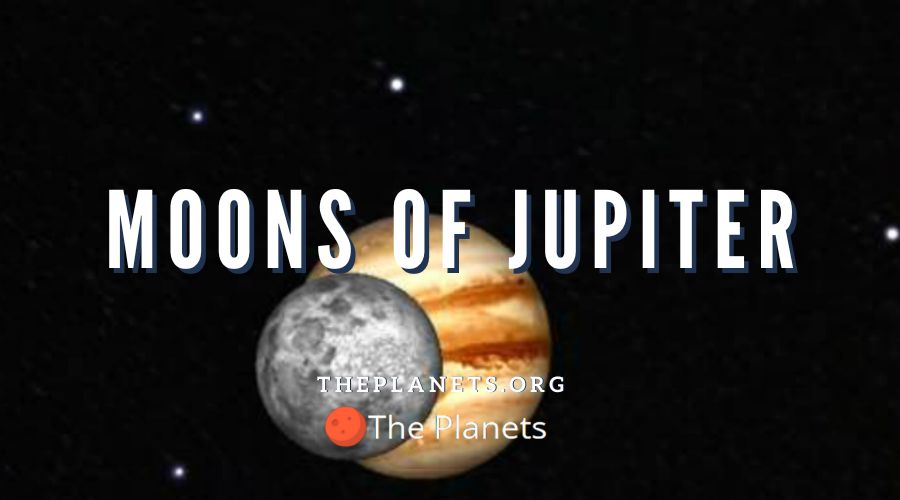
The groups of Jupiter’s moons
Jupiter’s moons are often split into three specific groups:
-
Inner moons
These are the moons which orbit closest to Jupiter and they are sometimes known as the Amalthea group. The names of the inner moons of Jupiter are Metis, Adrastea, Amalthea, and Thebe.
-
Galilean moons
The largest four moons of Jupiter – Io, Europa, Ganymede and Callisto – were discovered by Galileo in 1610 and are known as the Galilean moons. They each have a radii larger than any of the dwarf planets and they are some of the largest objects in the solar system outside of the eight planets by mass. Ganymede is actually larger than Mercury in diameter.
-
Outer moons
The other moons are known as irregular satellites because of their eccentric and distant orbit paths. They are the furthest from Jupiter and are substantially smaller objects. Many of these moons are captured asteroids pulled in by the gravitational forces of Jupiter.
Facts about the inner moons of Jupiter
Metis
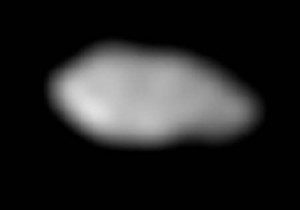
Discovered by Stephen Synnott through images taken by the Voyager 1 in 1979, Metis is the closest moon to Jupiter. It has a diameter of 40 km (25 miles) and orbits Jupiter in 0.294780 Earth days, which is faster than Jupiter rotates on its axis.
It is named after the Greek Titaness Metis, who was the first wife of the god of the skies, Zeus. It is thought that Metis is an asteroid that was captured by Jupiter’s gravity. The moon orbits at 128,000 km (79,500 miles) from Jupiter and has a mass of 9 x 1016kg.
Adrastea
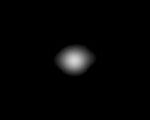
The second closest moon to Jupiter is Adrastea which has a diameter of 20 km (12 miles)12 miles (20 km) and orbits 129,000 km (80,000 miles) from Jupiter. It was discovered in 1979 by David Jewitt using the Voyager 2 and is named for the Greek goddess Adrasteia, who passed out rewards and punishments.
Adrastea has a mass of 1.91 x 1016kg and like Metis it orbits Jupiter faster than it takes for Jupiter to rotate on its axis – in 0.29826 Earth days.
Amalthea
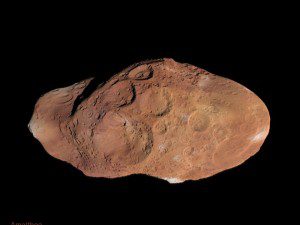
Amalthea is the third moon from Jupiter and is the reddest object in the solar system. It was discovered by Edward Emerson Barnard in 1892. Amalthea is not a spherical moon with a diameter of 232 x 146 x 134 km (145 x 91 x 83 miles). It orbits 181,300 km (112,700 miles) from Jupiter, located in the faint Gossamer ring.
The moon is named for Amalthea in Greek mythology, who was the foster-mother of Zeus and nursed the god of the skies when he was a baby with goats milk. It is the largest of the inner moons of Jupiter and is most likely an asteroid captured by Jupiter. It takes Amalthea 0.49817905 Earth days to orbit Jupiter and like all the inner moons, it is tidally locked to the planet – the same side of the moon always faces Jupiter. Amalthea also gives off more heat than it receives from the Sun.
Thebe
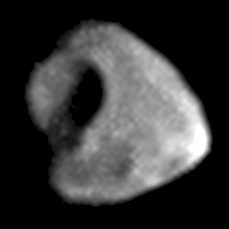
The fourth moon from Jupiter is Thebe. It has a diameter of 110 x 90 km (68 x 56 miles) and orbits 222,000 km (138,000 miles) from Jupiter. Thebe was discovered by Stephen P. Synnott in 1979 and officially named in 1983.
In Greek mythology, Thebe was a nymph and the daughter of the river god Asopus. It is likely that Thebe, along with Amalthea, provide the dust for the Gossamer ring where they are located. Thebe has a mass of 8 x 1017kg and it takes the moon 0.6745 day Earth days to orbit Jupiter.
Facts about the Galilean moons of Jupiter
Io
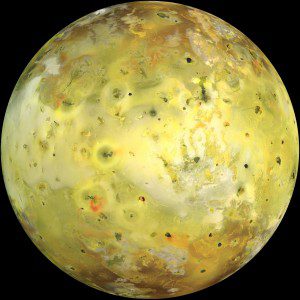
Io is a large, rocky and volcanically active moon which is very vivid with bright colors due to the molten sulfur that they volcanoes spit out. These violent conditions mean that it is not the kind of world which would be able to sustain human life. In fact, Io lies in the doughnut-shaped plasma cloud around Jupiter, known as the “Io plasma torus” which is the result of Jupiter’s very strong magnetic field.
As Io rotates, this torus strips ions from Io as it rotates, effectively making it an electrical reactor. The result is a level of radiation on Io that is 1000x stronger than the level needed to kill a human being.
With a diameter of 3,636 km (1,942 miles), Io is very close in size to our Moon and it is around 422,000 km (220,000 miles) from Jupiter. Io has a mass of 8.93×1022 kg and takes 1.77 Earth days to orbit Jupiter.
Europa
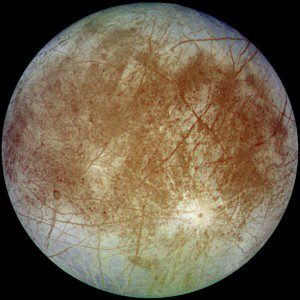
Europa is a large, dense and icy moon of Jupiter with a very smooth surface – it is the smoothest object in our solar system. The surface of Europa is covered with long, crisscrossing trackway but it has few craters. Around 3.8 to 4.1 billion years ago, many objects in the solar system were bombarded with asteroids and comets – a period known as the Late Heavy Bombardment Period. Since Europa is so smooth, it is believed that the moon, like Earth, has been able to recover its surface.
One scientific theory is that Europa contains a large liquid water ocean heated by its corde beneath the frozen icy shell – making it a world that may be able to sustain human life.
Europa has a diameter less than 3,138 km (2,000 miles) making it smaller than the Earth’s moon. Europa orbits Jupiter in 3.55 days, sits at a mean distance of 670,900 km (420,000 miles) from Jupiter and has a mass of 4.80×1022 kg.
Ganymede
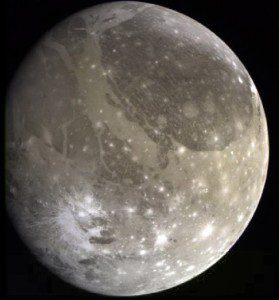
The largest moon of Jupiter is Ganymede – a large, icy moon with a diameter of around 5,268 km (3,400 miles) that is scarred with craters. It is larger in diameter than the planet Mercury and the dwarf planet Pluto. In fact, Ganymede is the largest moon in the solar system.
Named for the handsome Trojan boy that Zeus took away to be the cup bearer for the gods, Ganymede has a magnetic field and is believed to have a molten iron core. It takes the moon 7.15 earth days to orbit Jupiter. Ganymede’s mass is 1.48×1023 kg and it orbits Jupiter at a distance of around 1,070,000 km (664,000 miles).
Callisto
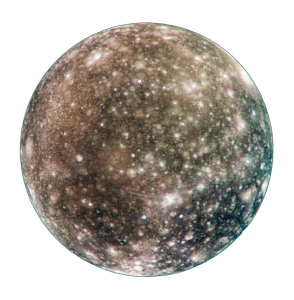
Callisto is the eighth moon of Jupiter and is a large, dark but low-density moon which is covered with impact craters. It is home to the Valhalla crater, which is nearly 4,000 km in diameter and the largest crater in the solar system. It is the outermost of the Galilean moons, orbiting 1,883,000 km (1,170,000 miles) from Jupiter.
It takes Callisto 16.7 days to complete its orbit around Jupiter and during that time it will have travelled more than seven million miles. Callisto has about 99% the diameter of the planet Mercury, but has only 1/3 the mass at 1.08×1023 kg.
Facts about the outer moons of Jupiter
Leda
Leda is the ninth moon from Jupiter and is also the smallest moon with a mean diameter of 16 km (9.9 miles). Charles Kowal discovered Leda in 1974. It is named for the queen of Sparta and the mother of Pollux and Helen of Troy – the father was Zeus. The moon has a mass of 5.68 x 1015kg. It takes 238.72 Earth days for Leda to orbit Jupiter and it orbits at a distance of 11,094,000 km (6,900,000 miles) from the planet.
Himalia
Jupiter’s tenth moon is Himalia, discovered by Charles Perrine in 1904. Himalia is 170 km (110 miles) in diameter and orbits 11,480,000 km (7,000,000 miles) from Jupiter. The moon is named after a nymph who produced three sons with Zeus (Jupiter). It has a mass of 9.5 x 1018kg and takes 250.5662 days to orbit Jupiter.
Lysithea
The eleventh moon from Jupiter’s surface is Lysithea, a world which is 24 km (15 miles) in diameter and orbits at around 11,720,000 km (7,200,000 miles) from Jupiter. It has a mass of 8 x 1016kg and takes 259.22 Earth days to orbit Jupiter. Lysithea is named after the daughter of Oceanus in Greek mythology. Lysithea was discovered in 1938 by Seth Nicholson.
Elara
Elara was discovered in 1905 by Charles Perinne and is Jupiter’s twelfth moon. It has a diameter of 80 km (50 miles) and orbits Jupiter at a distance of 11,737,000 km (7,250,000 miles. Elara has a mass of 8 x 1017kg and takes 259.6528 Earth days to orbit Jupiter. It is named after Elara from Greek mythology, the mother of the giant Tityus, fathered by Zeus.
Ananke
Ananke, Jupiter’s thirteenth moon, was discovered in 1951 by Seth Nicholson. Ananke has a diameter of 20 km (12.5 miles) and orbits 21,200,000 km (13,100,000 miles) from Jupiter. The moon has a mass of 4 x 1016kg and it take Ananke 631 Earth days to orbit Jupiter. The moon is also in a retrograde orbit – which means it orbits in the opposite direction of Jupiter. It is named after Ananke, the mother of Adrastea by Zeus, in Greek mythology.
Carme
Discovered in 1938 by Charles Nicholson, Carme is the fourteenth moon of Jupiter. It has a diameter of 30 km (18.5 miles) and orbits at a distance of 22,600,000 km (13,800,000 miles) from Jupiter. Carme has a mass of 9 x 1016kg and orbits Jupiter in 692 Earth days. It is in a retrograde orbit which moves in the opposite direction of Jupiter. In Greek mythology Carme was the mother of Britomartis, a Cretan goddess, fathered by Zeus.
Pasiphae
Pasiphae is the fifteenth moon of Jupiter and was discovered by P. Melotte in 1908. It orbits Jupiter at a distance of 23,500,000 km (14,600,000 miles) and has a diameter of 36 km (22 miles). Its mass is 2 x 1023kg and it takes Pasiphae 735 Earth days to orbit Jupiter in a retrograde orbit path. In Greek mythology, Pasiphae was the wife of Minos and mother of the Minotaur.
Sinope
Jupiter’s sixteenth moon is Sinope, discovered in 1914 by Seth Nicholson. Sinope has a diameter of 28 km (17.5 miles) and it orbits Jupiter at a distance of 23,700,000 km (14,700,000 miles). It has a mass of 8 x 1016kg and it orbits Jupiter in a retrograde orbit that takes 758 Earth days. In Greek mythology, Sinope was a woman who was courted unsuccessfully by Zeus, and she remained a virgin for her entire life.
Callirrhoe
Jupiter’s seventeenth confirmed moon was Callirrhoe, also known as S/1999 J 1, and was discovered by Tim Spahr on July 18, 2000. It has a diameter of 8.6 km (5.3 miles) and orbits Jupiter at a distance of 24,100,000 km (14,975,000 miles). Callirrhoe has a mass of 9 × 1014kg and orbits Jupiter in a retrograde orbit that takes 758.77 Earth days to complete. In Greek mythology, Callirrhoe was the daughter of the river god Achelous, one of Zeus’ (Jupiter’s) many conquests.